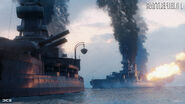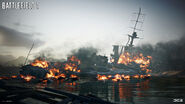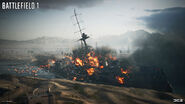A dreadnought is a class of naval vessel that was the result of an arms race leading into World War I. The British Royal Navy battleship HMS Dreadnought led the way towards warships that exclusively used heavy-caliber guns and usually powerful steam turbines. Other Navies had planned similar "all big gun" ships concurrently with the HMS Dreadnought, such as the American South Carolina class, and the Japanese semi dreadnoughts Satsuma and Aki. However, Dreadnought was the first completed and thus defined all similar classes of ships following her up until the "gast battleships" of the interwar and WWII periods developed from battlecruisers.
Previous battleships relied on a mixed battery of few large guns with many smaller guns, and reciprocating steam engines for propulsion. Many early dreadnought designs like HMS Dreadnought, such as the German Nassau and Japanese Mikasa, used an orthodox placement of turrets, with one pointing forward. The South Carolina and American battleships in general are notable for having all turrets in the now conventional centerline placement, with usually two pairs of "superfiring" turrets, where both turrets have the same limitations on rotation and thus can fire on an intended target in pairs. This design also allows for weight reduction and efficient use of the main battery in a broadside on either side of the ship. The Iron Duke Class featured in Battlefield 1 uses this center line placement.
Battlefield 1
- This item has a Codex entry: Dreadnought
The Dreadnought serves as a Behemoth on naval maps such as Empire's Edge and Fao Fortress in Battlefield 1. It is modeled after the British Royal Navy's HMS Iron Duke-class dreadnoughts. They also appear in the singleplayer War Story The Runner, where the player character Frederick Bishop will direct a dreadnought barrage to signal the openings of the beach landing. A burning dreadnought wreck also appears in the background of Suez.
It is able to accommodate a total of 4 players (the lowest of the three Behemoths, with the other two housing up to 6, despite the dreadnought being the biggest of them). Seat 1 is reserved for the captain in control of the dreadnought, positioned on the ship's bridge, who also has the frontal two turrets at disposal, similar to the armored train's cannons. Likewise seat 2 has control over the two rear turrets. Each set of cannons cannot be fired independently but only in a sequential salvo when all four are reloaded. Nevertheless they deal devastating damage, a single shell being able to level a whole building and a full barrage able to turn even the heaviest fortification walls into rubble. The captain must be mindful of orienting the dreadnought in a position where the rear turrets can contribute to battle.
Seats 3 and 4 control the single starboard and port AA cannons respectively, which also act as the sole defensive armament of the dreadnought. The midships turret and all secondary gun batteries are unusable and merely visual.
Attacking the Dreadnought
- This item has a Codex entry: Giants of the Seas
The biggest threat to the dreadnought is the M.A.S. Torpedo Boat, which can quickly deliver torpedoes to bear.
Bombers can be effective, especially with the Torpedo Package that greatly increases their engagement range.
Close to shore, the dreadnought may be in range of Fortress Gun or FK 96 emplacements and tanks.
Trivia
- There is currently an issue where players in the AA turrets can spot and shoot through the dreadnought at targets they cannot actually see. This same issue also allows airplane gunners to fire through their own vehicle.
- Only one dreadnought, the USS Texas (BB-35) remains in good condition today, and is now a museum in the Houston ship channel, next to the San Jacinto monument near Houston, Texas. The IJN Mikasa, a pre-dreadnought, is the only older battleship.
- Many dreadnought battleships were destroyed (USS Florida and first USS Washington) or repurposed (USS Wyoming and Utah) with the Washington and London Naval treaty limitations occurring in 1921 and 1930 respectively. Hence, only one remains preserved today. Many dreadnoughts also served in WWII but were either sunk in combat or used in atomic bomb tests after the war, with their remains sometimes becoming popular diving or SCUBA sites.
Gallery
| |||||||||||||||||||||||||||||||||||




